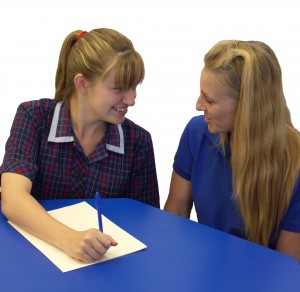
All languages have a grammar system that helps people organise information in a consistent way when they are speaking to each other. Most children naturally learn this system through talking with adults as they develop, so that by the time they are around four years old their development is almost complete and just needs a little fine tuning.
Some children however have difficulty understanding and using grammar, perhaps because of a language or learning difficulty, or because of hearing or auditory processing difficulties. This can impact on their ability to understand what others are saying and their ability to communicate effectively. Later on it can effect reading, written language and learning. Support from a speech pathologist can help children develop these important skills.
Grammar includes the way words are ordered in a sentence and the way certain words and word endings are used to modify the other words in a sentence to make the meaning clearer. For example if we take the words “dog, chase and cat” we can use grammar to make different meanings such as “the dog will chase the cat, the dog chased the cat, the dog is chasing the cat, the dog was chased by the cat, the dog was not chasing the cat etc.” Children with difficulties with grammar would have difficulty understanding and forming these different sentences.
Signs that a child has difficulty with grammar include:
- words in sentences in the wrong order after three years “me eat no”
- words left out of sentences after three and a half years “not eat apple”
- errors in the use of regular grammar after four years (pronouns “he/she/I/they”, verb tenses “is -ing, -ed” articles “a/the”) “her running”
- errors in the use of irregular grammar after seven years (irregular plurals “mice/feet/children” and irregular verbs “went, fell, drew”) “I drawed it”
- difficulty using simple conjunctions (and, then, so) to join sentences after four years
- difficulty using complex conjunctions (because, but, when, after) to join sentences after six years
- grammatical errors or words missed out in writing after seven years.
- difficulty using simple conjunctions in writing after seven years
- difficulty using complex conjunctions in writing in middle primary school.
Children with these types of difficulties would benefit from a language assessment by a speech pathologist.
When helping children to learn to use grammar work though the following steps:
- Modelling: Here is a boy. He is running.
- Comprehension: Look at these pictures and show me ‘He is running’.
- Imitation: You tell me the sentence – ‘He is running’.
- Forced Choice: Is it he or she?
- Sentence closure/expression: Who is running….
- Practice/ generalisation: Tell me about what your friend is doing.
Practice at each step until your child is confident and able to respond correctly 9 times out of 10 before moving onto the next step. Information and activities to help your child develop some common grammatical structures can be downloaded from the downloads section of Our website.
Other ways to help children develop grammar skills include:
Modelling. This involves showing the child how to use a word or sentence structure correctly by giving the child lots of examples as you talk together. “Look, he is a boy, he is running, he is running up the hill, he has a kite, he is flying the kite”. The child does not need to repeat you, just hear lots of examples of how the word is used correctly. You can emphasis the modelled word a little but keep it sounding friendly and natural.
Recasting. This is when you take a sentence that the child has said incorrectly and change it to the correct form. Child “look him is running”, adult “yes, he is running” Recasting should be done in a positive and natural way and can be followed by some extra modelling of similar sentences.
Fixed up ones routine. This is based on the work of Caroline Bowen and aims to show the child how to self monitor and correct their own communication. First the adult makes a mistake in their own speech and “fixes it”. Look him is running, ooops I meant to say “he is running” I had to fix up that one”. Later the adult can cue the child “oops can you fix up that one” when the child makes the error.
Sentence transformations. The adult can take a sentence the child has said incorrectly and write it down correctly on a strip of paper. The adult and child read the sentence together and then cut the sentence into separate words. You can also cut off word endings such as: ing, ed or plural “s”. The child then puts the sentence back together. The adult can talk to the child about the correct word order, and help them find the right place for the word endings. This activity helps school age children see as well as hear how to use the grammatical words and word endings correctly.
Reading written work aloud. Encouraging children to read their work aloud helps then to hear when their grammar does not “sound right” and encourages them to self monitor and self correct their written work. You can use the steps above if the child needs help to correct their errors.
Using a grammar check on the computer. Show the child the difference between the spell check and the grammar check and explain that the grammar check means the words are not right. Help them to read aloud and correct grammatical errors as they write.
These strategies can be used for a range of different grammatical structures. Watch out for future blog entries will give specific ideas for developing the most common grammatical structures that children often find difficult.
Related Blog Posts
If you liked this post you may also like:
Writing Skills
Using SNAKES & LADDERS To Grow
Now let's play
Boost brain power!



